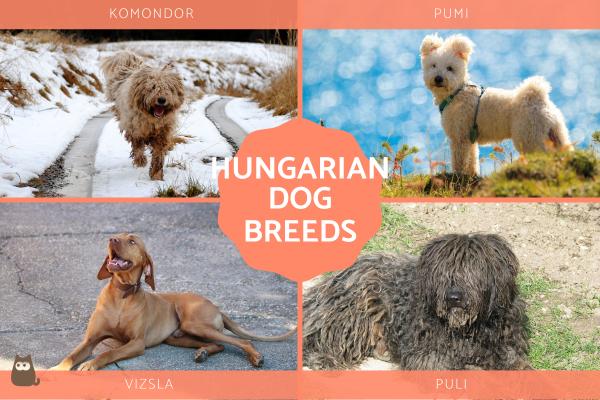
The extensive area surrounding the Carpathian Mountains saw the birth of a great variety of dog breeds. While they share a common origin, their physical and behavioral characteristics can vary greatly. Although the boundaries of modern-day Hungary may have changed over time, the animals we present on our AnimalWised list of Hungarian dog breeds can be said to be from this country. Especially the ancient breeds, many were used as working animals for hunting, defense, herding and many other practical tasks. Today, many of these animals are still employed as working dogs, but they have also grown popular as companion animals.
The 8 Hungarian dog breeds we provide on this list are all recognized by the International Canine Federation (Fédération Cynologique Internationale or FCI). We provide information about their characteristics and photos of each breed so you can see what they look like.
Vizsla (Hungarian Shorthaired Pointer)
Considered the national dog breed of Hungary, the Vizsla was bred with the aim of accompanying falconers on their hunts across the Hungarian plains. They would then collect the prey after the falcons dispatched them. During World War II, the breeding of these dogs was affected to the point they were on the verge of disappearing completely. The breed managed to persist and was exported elsewhere from the 1950s onwards.
Through crossbreeding with other hunting dogs such as the Pointer or the Weimaraner, the Vizsla standard was modified until it became an extremely athletic and resistant dog. They are very versatile and with an unbeatable sense of smell.
There are two varieties of Vizsla, the short-haired and the wire-haired. Both varieties are represented by dogs of a medium to large size, weighing between 18 and 30 kg (40-66 lb). They have a slim, but strong constitution, large hanging ears, a long tail and generally honey-colored eyes. Their coat is copper red and uniform in color. The wire-haired vizsla is slightly larger and has a coarser and longer coat, with a beard on their muzzle.
The Vizsla has a friendly temperament. They are a curious, intelligent and somewhat independent animal, although they are also affectionate and protective of family. They need a lot of physical and mental stimulation. A born athlete with lots of energy, they are the ideal companion for those who enjoy taking long walks in nature or going out to exercise frequently. The Vizsla life expectancy is between 12 to 15 years.
Learn more with our breed file on the Vizsla dog breed.
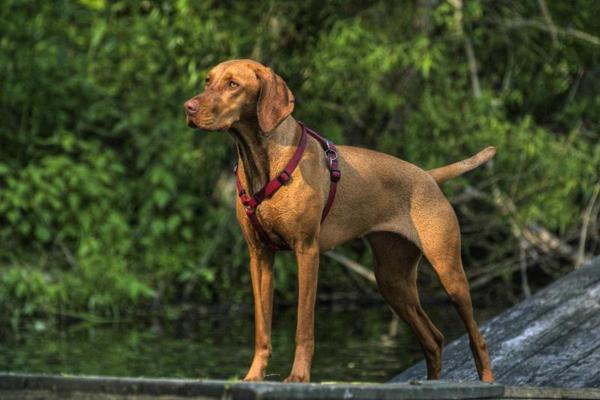
Komondor
Also called the Hungarian Shepherd, the Komondor has an unmistakable appearance that makes them unique in the canine world. This breed has been used for centuries to guard and protect herds from attacks by wild animals. It is said their physical appearance was modified with the aim of creating a dog that looks like sheep so they can protect through camouflage in a herd.
The Komondor is a giant-sized dog. They can weigh more than 60 kg (132 lb) and reach a height of 80 cm (31.5") at the withers. Their most remarkable physical characteristic is their long ivory fur that covers their entire body. Their undercoat is made up of fine, shaggy hair, while the outer layer is in the form of tangles that give the impression the dog is covered in dreadlocks. Much time must be spent keeping their coat in good condition.
Underneath these cords of fur, their body is strong and muscular. Their nose is dark in color, as are their eyes. They have two floppy ears that it barely raise when alert.
Bearing in mind that this breed has historically been bred to defend herds, it is not surprising we find ourselves with a very brave, independent and decisive dog that tends to mistrust strangers. They are protective and territorial with their family and his environment. It is not a suitable dog for inexperienced guardians, but properly socialized and educated, they are a very calm and affectionate animal with a great relationship to children.
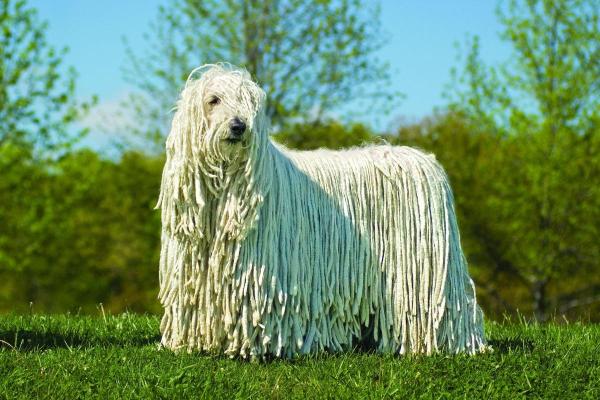
Kuvasz
The origins of the next Hungarian dog breed goes back to the Magyares, nomadic tribes from Asia who settled more than ten centuries ago in the territory that today corresponds to Hungary. These tribes moved with large herds of sheep and used the ancestors of the Kuvasz to defend their animals from attacks by wolves and bears.
During the reign of Matthias Corvinus in 15th Century Hungary, this breed began to be used as a hunting dog. Although you can still see Kuvasz dogs accompanying cattle in some regions today, these dogs are more commonly trained mainly to work alongside the Hungarian army and police. They have also become popular as a guard dog or as a companion animal.
Kuvasz dogs are very large and strong animals with a robust head, a well-developed jaw, black nose and lips, drooping ears and a long, curved tail covered with a lot of hair. Their beautiful coat is completely white, thick and wavy. Their adult weight ranges between 45 and 50 kilos (100-110 lb). They are very resistant and can easily adapt to different climates and environments.
As in the case of the Komondor, the Kuvasz is a guard dog. This can make them somewhat distrustful of strangers, but they are very brave, self-confident and protective of family and territory. Despite their size, the Kuvasz is very agile and active. They enjoy being outdoors and needs a lot of stimulation, so it is not a suitable dog for people who are inexperienced or who do not have enough time or space.
If you do want a dog suitable for smaller homes, take look at our list of dogs suitable for apartment living.
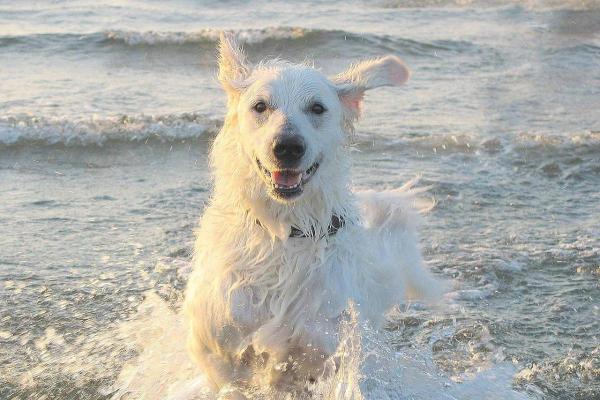
Mudi
The Mudi is a little-known dog breed that emerged in Hungary. They were originally used to accompany shepherds and guide herds of sheep, goats or cows. Their incredible versatility, marked intelligence and great capacity for adaptation have today made the Mudi a dog that stands out in many areas, not just in herding.
Mudi dogs have been used in the following areas of work:
- Hunting
- Search and detection
- Guard and defense
- Canine sports (e.g. dog agility or canicross)
- Animal companion
The Mudi is a small to medium sized dog with a weight ranging between 8 and 13 kilos (18-29 lb). Their body is well proportioned and athletic. They have erect, fur-covered ears that provide lively and always attentive appearance. Their tail is covered with long hair which curls on their back when in motion. Some anuran specimens can be born, i.e. they are born without a tail. The Mudi's coat is wavy, shiny and between 3 and 7 centimeters long.
Accepted colors of the Mudi breed are:
- Bay
- Brown
- Black
- White
- Gray
- Blue Merle
This canine breed is especially intelligent and has an incredible ability to learn. You need to keep them active and provide physical and mental stimulation on a daily basis to ensure their well-being. They are also energetic, brave and very faithful, making them the ideal companion for a dynamic family with experience in dog education and training.
Read our related article to learn more about the most intelligent dog breeds.
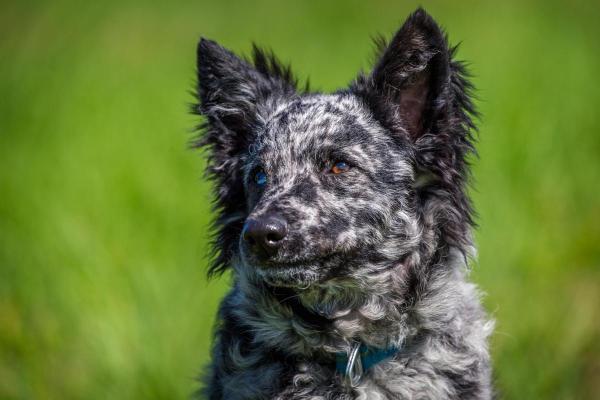
Puli
At first glance, the Puli looks similar to the Komondor, but it is much smaller in size. They weigh between 13 and 15 kg (28-33 lb) as an adult. The origins of the Puli also date back to the time of the nomadic Magyares tribes who settled in Hungary centuries ago and who used these dogs as support to control and guide herds.
The Puli has a well-proportioned body and a small, rounded head. This head sports two drooping V-shaped ears, with a dark nose and eyes. Their short, high-set tail that is hidden in their dreadlocked fur. As with the Komondor, the Puli is not born with their characteristic cords. These matted cords develop as they mature. Although their coat care isn't complicated, it can be intensive. Their coat colors are white, black, fawn and grayish.
Regarding their temperament, they are a very energetic, agile and resistant dog which loves to exercise and play. Although somewhat reserved with strangers, the Puli is generally an affectionate anima. If properly socialized, they are very patient and tolerant of children and other dogs. In addition, they are remarkably intelligence and learn quickly, so it is quite easy to teach them tricks and commands.
Find out more about what to teach your dog with our basic dog training guide.
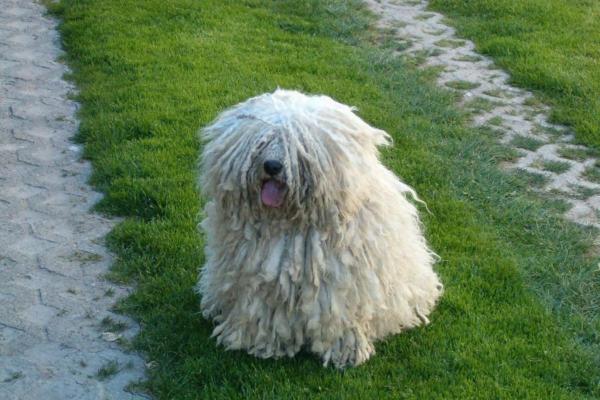
Pumi
The Pumi is a is a Hungarian dog breed little known outside their country of origin. This breed was born from a cross between Hungarian Pulis and terrier-type dogs with erect ears, originating in most cases from France and Germany. Originally, they were mainly used as a type of shepherd dog, but today most Pumis live at home as companion animals.
The appearance of the Pumi is very peculiar, particularly their erect ears which fall slightly forward. The head is reminiscent of terrier-type dogs as it is robust and ends in a fine and elongated snout. The Pumi has very wavy and bushy hair, shorter on the face than on the body. The hairs on their ears are coarser and stiffer, giving them a characteristic ‘disheveled’ appearance. Individuals can be white, black, gray, cream or fawn. Their adult weight ranges between 8 and 15 kg (17.5-33 lb).
This breed has a cheerful character and is always ready for action. They are very lively and energetic, making them the ideal dog for active tutors who enjoy sport and have experience in canine education. They also stand out for being very brave and protective, but they mistrust strangers and can bark quite a lot.
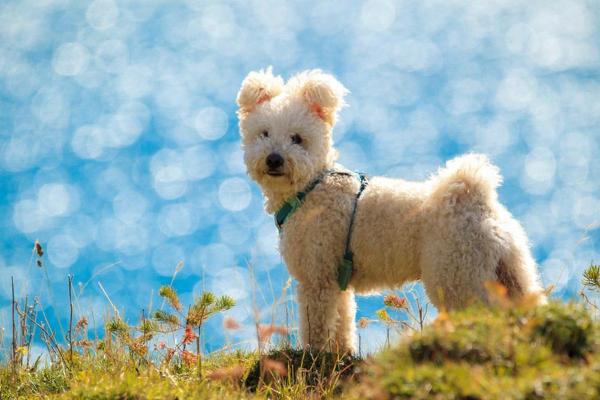
Transylvanian Hound
Also known as the Hungarian Hound, the Transylvanian Hound is a very old breed of dog. Despite their name implying a Romanian origin, this is a Hungarian dog breed. They were developed in the Middle Ages to have a great sense of smell and great physical resistance. They were used to follow trails and catch prey during the hunt.
Because the Carpathian area has widely varied terrain, two varieties of Transylvanian Hound were selectively bred:
- Long-legged Transylvanian Hound: was used for hunting big game on flatter terrain.
- Short-legged Transylvanian Hound: used for hunting small game in areas with a lot of vegetation and difficult access.
Although there may be some variation in size between specimens, only the large variety of Hungarian Hound remains. This dog is strong and athletic, very brave and physically resistant, meaning they require frequent exercise. They have small brown eyes, floppy ears and a long, muscular tail. Their hair is short, thick and hard. Their coat color is shiny black with some areas tan, especially on the snout, chest and distal area of the legs. The weight of an adult Hungarian Hound is around 25-30 kg (44-66 lb).
This breed stands out for being very persevering, brave and determined, especially when at work. They have a great decision-making capacity, so they tend to be somewhat stubborn and independent. They are also a happy, faithful, sociable and playful animal, especially in their adolescent stage.
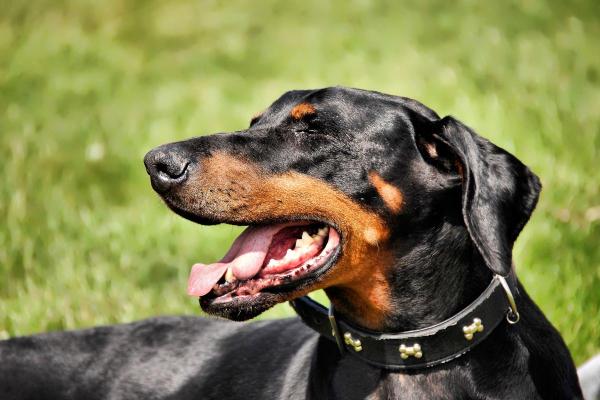
Magyar agár
The Magyar agár is sometimes known as the Hungarian Greyhound, but this name is not entirely accurate. While they are a type of sighthound breed, they are distinct from Greyhound lineages. They also date back to the Magyares tribes. This breed remained unchanged until the 19th century when they become crossed with English Greyhounds. In doing so, the idea was to increase the speed and endurance of the Hungarian dog breed.
This canine can reach 31 kg (68 lb) in weight and 70 cm (27.5") in height at the withers. Their appearance is typical of sighthounds, i.e. they have a slim and athletic build, narrow head, fine snout, long limbs, ears with drooping tips and a strong tail curved at the end. Their coat is very short and rough to the touch and can present in a wide variety of colors and patterns.
The Magyar agár is one of the fastest dogs that exist , surpassing even the English Greyhound over long distances. For this reason, there are those who use these dogs to chase and kill rabbits and hares in the field. As a companion dog, they are suitable for various types of homes. Although a born athlete, they are also a calm, intelligent, affectionate and sociable animal. It is important they are acquainted different stimuli from a puppy and always educated in a positive way, as they are a fairly sensitive and reserved dog.

If you want to read similar articles to Hungarian Dog Breeds, we recommend you visit our What you need to know category.